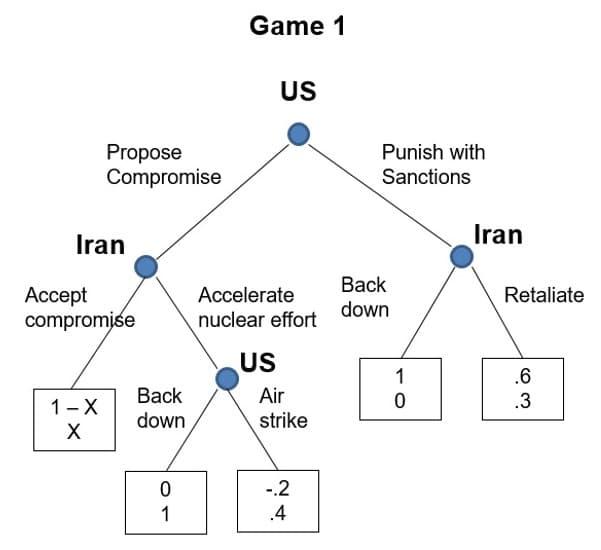Now let’s consider a more complicated game. In Game 1 below, the US and Iran are bargaining over the state of Iran’s nuclear program. The US must first decide whether to impose sanctions on Iran or propose a compromise. If the US imposes sanctions, Iran can either back down or retaliate. If the US proposes a compromise, Iran can either accept it or accelerate its nuclear effort. If Iran does the latter, the US can either back down (i.e., the US is “weak”) or conduct an air strike (i.e., the US is “strong”). The background to this game is similar to ones we have discussed before. Iran’s nuclear program can range from 0 to 1, where 0 means no nuclear program and 1 means a fully functioning nuclear weapon. Any intermediate compromise X (which must lie between 0 and 1, 0 < X < 1) gives Iran a utility of X and the US a utility of 1-X. Payoffs for the other outcomes are as shown in the cells: the top number represents the US payoff, and the bottom number represents Iran’s payoff. (Don’t worry about where these numbers come from—just take them as given.) QUESTION: What is the equilibrium to Game 1? Group of answer choices US punishes with sanctions, Iran retaliates US punishes with sanctions, Iran backs down US proposes compromise, Iran accepts US proposes compromise, Iran accelerates nuclear effort, US backs down US proposes compromise, Iran accelerates nuclear effort, US conducts an air strike
Now let’s consider a more complicated game. In Game 1 below, the US and Iran are bargaining over the state of Iran’s nuclear program. The US must first decide whether to impose sanctions on Iran or propose a compromise. If the US imposes sanctions, Iran can either back down or retaliate. If the US proposes a compromise, Iran can either accept it or accelerate its nuclear effort. If Iran does the latter, the US can either back down (i.e., the US is “weak”) or conduct an air strike (i.e., the US is “strong”).
The background to this game is similar to ones we have discussed before. Iran’s nuclear program can range from 0 to 1, where 0 means no nuclear program and 1 means a fully functioning nuclear weapon. Any intermediate compromise X (which must lie between 0 and 1, 0 < X < 1) gives Iran a utility of X and the US a utility of 1-X. Payoffs for the other outcomes are as shown in the cells: the top number represents the US payoff, and the bottom number represents Iran’s payoff. (Don’t worry about where these numbers come from—just take them as given.)
QUESTION:

Trending now
This is a popular solution!
Step by step
Solved in 2 steps with 6 images


